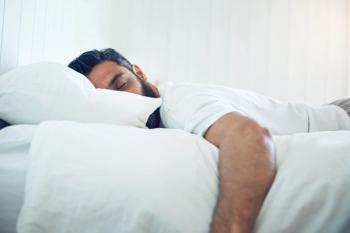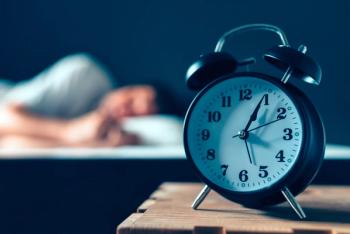
Insomnia Associated With Shift Work Sleep Disorder
A case of a patient with difficult-to-treat insomnia highlights the pervasive daytime effects of this condition.
CASE REPORT
Shift work sleep disorder is characterized by insomnia and excessive sleepiness lasting for at least 3 months in association with fluctuating work schedules. Patients who have this disorder experience an overall decreased amount of sleep. As defined by the
Because the inherent circadian rhythm is largely regulated by the 24-hour light/dark cycle, people who work overnight generally feel sleepier at night than during the day, even when they are at work or have slept during the day. Patients who work schedules with some or all shifts during the night when they would otherwise be sleeping may consequently experience disruptions in their circadian rhythm. These disruptions affect one’s ability to get adequate sleep, even when they have enough time to sleep. Most people who have shift work sleep disorder have
Sleep disruption is also associated with behavioral manifestations of mood changes, such as irritability and social withdrawal. In addition to fatigue as a contributing factor, when mood changes like depression and anxiety are associated with shift work sleep disorder, they are thought to be caused by molecular alterations linked to circadian rhythm disruption. Research
Many shift workers are unable to adjust their circadian rhythm to their altered sleep wake schedules. This is evidenced by samples of salivary melatonin concentration, which normally
Many pharmacological treatment strategies have been used to treat this acquired sleep disorder, including melatonin, zopiclone, lormetazepam, and modafinil. For example, one
Case Vignette
A 47-year-old man has trouble falling asleep and reports not getting enough sleep throughout the night. He says he has no energy to do anything other than work and sit around at home.
His wife and daughter have accompanied him to the office visit. They explain that his moodiness has gotten worse over the past year. They say that he is irritable and sometimes seems down and uninterested in talking with them at home.
The patient works rotating shifts in a factory and has had the same job and schedule for about 5 years. He works 10-hour shifts with a schedule that varies weekly. He is scheduled to work from 10 PM to 8 AM on any 4 days of 1 week, followed by a week of working any 4 days from 10 AM to 8 PM. When an extra shift opens up with bonus pay, he takes it. He has often come home and gone back to work within 6 hours for an additional 10-hour shift when he can fit it in, which happens approximately 3 times per month.
The patient often tosses and turns in bed for hours before falling asleep, and sometimes he only gets a few hours of sleep before his next shift. He has not established a consistent sleeping pattern. He and his wife have installed heavy curtains with full window coverage to made sure their bedroom is completely dark during the daytime.
He agrees with his wife and daughter that he is quiet sometimes and irritable at others, but his family says these issues are getting progressively worse and he is very difficult to be around. The patient says he isn’t sad or anxious; instead, he is just tired and “zoned out.”
He gets enough to eat, and his wife is very attentive to planning healthy meals at home and packs healthy meals for him on his works days. He drinks 2 cans of caffeinated cold beverages at the beginning of every shift, and he doesn’t consume caffeine at any other time.
The patient smoked 1 pack of cigarettes per day since his 20s, but he quit about 5 years ago when a friend was diagnosed with lung cancer. He does not have any medical problems, and he isn't stressed at work or home. His physical examination is completely normal.
Evaluation and management
This patient was preliminarily diagnosed with shift work sleep disorder on his first visit. He and his wife agreed to keep a sleep diary over the course of 1 month. When they returned, they discussed the diary, which showed he had a very inconsistent sleeping schedule. He often came home and went to bed right away after a day or night shift, and sometimes he delayed going to bed for 3 to 7 hours after a day or an evening shift.
While shift work sleep disorder can cause diminished attention and increase the risk of accidents,1 this did not seem to be a problem for him. However, because he did not directly deal with equipment and rarely drove anywhere except work, he had limited opportunities to get into an inattention-induced accident.
The patient said that he did not want to look for a different job, as his pay rate and benefits were the best he had ever had in his life. He was advised to try to regulate his sleep schedule by going to bed at the same time every day during his week of night work and at the same time every day during his week of daytime work. He also wanted to try melatonin.
After several months, he was able to regulate his sleep on the weeks of his daytime shifts, but he still had an inconsistent sleep schedule on his week of nighttime work because he did not want to sleep during the day on his 3 days off. He continued to accept extra shifts whenever possible. He believed the melatonin helped him fall asleep and he felt that he was getting more rest on the days when he took it.
Overall, he did not have more energy, but he tried to be less irritable. His wife and daughter agreed he was more pleasant, yet still not very interactive. The family felt satisfied that learning about the disorder helped all of them cope with its clinical effects. They also all agreed the patient would aim eventually to get a job with a more regular schedule if he could find one without having to take a pay cut.
Take home points
• Some people are more susceptible to shift work sleep disorder than others, and the reasons for this predisposition are unclear.
• Shift work sleep disorder is extremely difficult to overcome with medication. Because some patients’ symptoms improve with medication, it may be worth trying for those who can’t change their work schedule.
• Alternative therapies have shown limited success in the management of shift work sleep disorder. Nevertheless, sleep education can help patients and families cope and may serve as a motivation to eventually change circumstances when possible.
Dr Moawad is Adjunct Professor at John Carroll University, and Instructor, Case Western Reserve University in Cleveland, OH. She is the Editor in Chief Emeritus of Neurology Times (2017-2019).
References
1. Boivin DB, Boudreau P. Impacts of shift work on sleep and circadian rhythms. Pathol Biol (Paris). 2014;62:292-301.
2. Gumenyuk V, Roth T, Drake CL. Circadian phase, sleepiness, and light exposure assessment in night workers with and without shift work disorder. Chronobiol Int. 2012;29(7):928-936.
3. Albrecht U. Molecular Mechanisms in Mood Regulation Involving the Circadian Clock. Front Neurol. 2017 ;8:30.
4. Liira J, Verbeek JS, Costa G, et al. Pharmacological interventions for sleepiness and sleep disturbances caused by shift work. Cochrane Database Syst Rev. 2014 12;(8):CD009776.
5. Slanger TE, Gross JV, Pinger A, et al. Person-directed, non-pharmacological interventions for sleepiness at work and sleep disturbances caused by shift work. Cochrane Database Syst Rev. 2016;(8):CD010641.
Newsletter
Receive trusted psychiatric news, expert analysis, and clinical insights — subscribe today to support your practice and your patients.

















